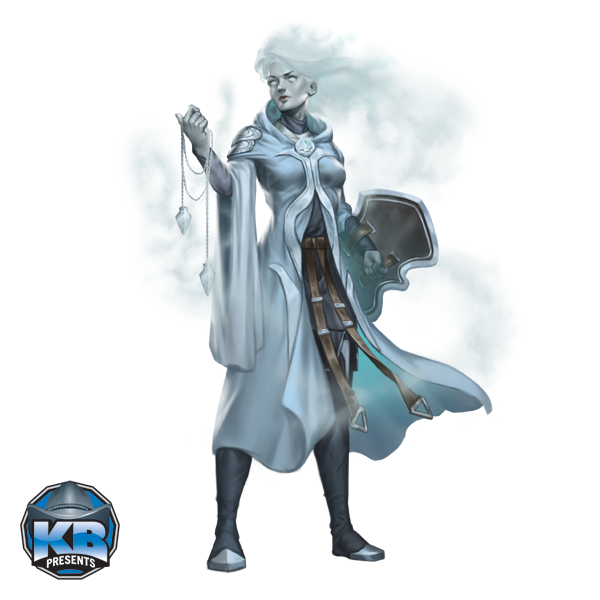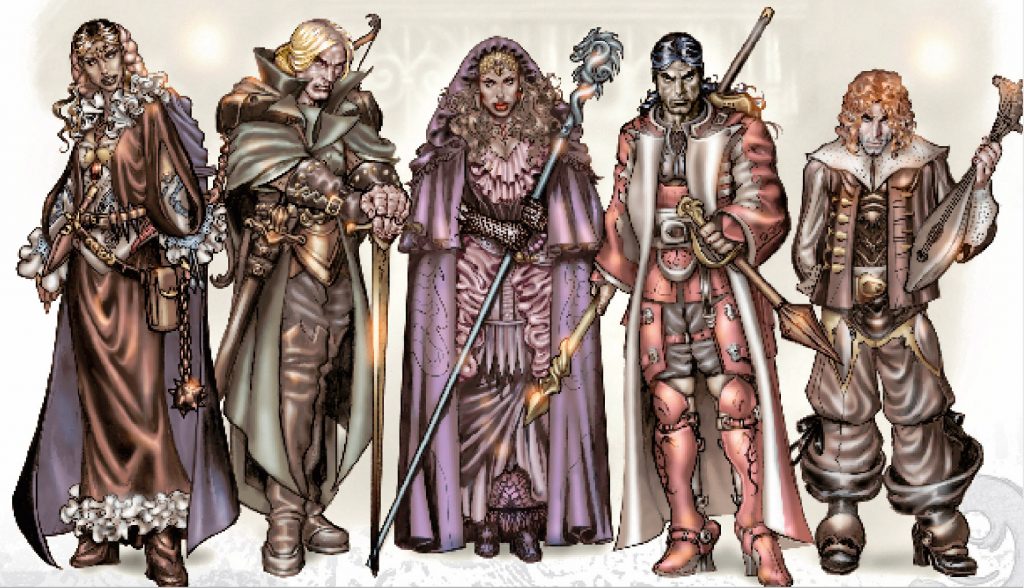
As time permits, I answer interesting questions posed by my Patreon supporters. Here’s another:
The Thrane fashion section is missing from Five Nations—any general ideas on how citizens of Thrane might dress distinctly differently from the other Five Nations?
In thinking of Thrane, it’s useful to contrast the forces shaping it to those that shaped its neighbors. Aundair has the widest penetration of everyday arcane magic and is also shaped by long-term interaction with the Fey. This leads to fashions that are wild and whimsical, to widespread glamerweave, cosmetic prestidigitation, and a general love of flamboyance and flair. On the other side, Karrnath has the harshest climate and the most martial culture. When it embraces fashion, it tends toward a gothic approach that is both grim and intentionally intimidating; the strong seek to SHOW their strength, and you see a definite martial element across general fashion. So with that said…
Faith is the cornerstone of Thrane. This predates both the Church of the Silver Flame and Thrane itself; before Galifar, the people of Daskara were devoted to the Sovereign Host. Divine magic is as important to Thrane as arcane magic is to Aundair, but that power comes from deep faith. I have always seen the typical Thrane as more humble and stoic than their counterparts in the other nations. A key element of the faith of the Silver Flame is the idea that we face a constant, shared threat—that people should be prepared to face supernatural evil and to protect themselves and their neighbors. We’ve called out that shared devotion—and practices like group archery—are key elements of daily life for the common Thrane. I see Thrane fashion as reflecting all of these things. They don’t seek to intimidate their rivals or to celebrate their martial prowess, as you see in Karrnath; and they don’t seek to shine the brightest or to dazzle their peers, as happens in Aundair. More than anything, Thrane fashion is SIMPLE and FUNCTIONAL.
Blue and silver are colors associated with the faith, and both of these colors are thus commonly seen throughout the populace. Now, it’s not that people don’t take pride in their appearance—but they aren’t especially driven by a desire to shine brighter than their neighbors; what is vital is to wear clothing that is PRACTICAL. More than any other nation, the people of Thrane know that dolgrims could burst out of the ground or ghouls could swarm out of the graveyard at any moment; so as a Thrane, you’re always thinking “Am I wearing something that would be practical in a zombie apocalypse?”
On a more specific level, I think that long coats and dusters are common in Thrane: simple, durable, versatile when it comes to weather. The same concept goes to boots and hats; in Thrane, a hat is designed to protect you from the sun and rain; in Aundair, a hat exists to make a STATEMENT, and its functionality is a secondary bonus.
This means that at a glance, Thranes have significant uniformity—similar colors, similar overall design of clothing. But it’s not a UNIFORM. And likewise, where an Aundairian will use Mending to repair damage and likely throw out (or recycle) clothing that is out of style, Thranes will wear their clothes to the bitter end and repair them by hand. They aren’t embarrassed to have clothing with patches or a cloak that’s clearly using a piece of another cloak. So while there’s a common overall style, there’s also a significant degree of tiny, unique details, as clothes evolve over time. I could also definitely imagine a patchwork aspect to clothing, almost like a quilt—where people specifically patch their clothes with pieces of cloth that have particular significance to them—heirlooms from family members, a strip from of the cloak of a heroic templar.
We can see some aspects of this reflected in Epitaph, the Thrane missionary pictured above. Epitaph is a priest, so there is a little flair to her outfit; I’d argue that her flowing sleeves are tied to a tendency to make sweeping gestures while preaching. But compared to Aundairian fashion, it’s a fairly SIMPLE outfit. There’s no glamerweave, no decorative embroidery, no jewelry, She’s wearing practical footwear. Her most prominent accessory is the symbol of her faith, as befits a missionary. Her clothing serves its purpose. Now, she doesn’t have the “patchwork” aspect I suggested above, but that’s not surprising for a missionary, who represents the Church; but the common templar isn’t embarrassed to wear a patched cloak, or their father’s long coat modified to fit their frame.
Is there a specific style of glamerweave that does incorporate silver, similar to how silverburn alters the colors of mundane fires?
The fashion potential of glamerweave is effectively limitless; it’s illusion imbued into cloth. The Church of the Silver Flame has a small but significant following in Aundair, and yes, I believe that Aundairian priests will often have burning lines of Sliver Flame traced on their robes. In my mind, Archbishoip Dariznu of Thaliost may take things even farther; I could imagine him in a silver cloak that appears to be trimmed in actual silver flames.
Does the sentiment of reducing waste and reusing things extend to food too, does Thrane have dishes equivalent to jok/congee, horchata or cod cakes, where the food can be prepared from leftover prepared food (examples far from exhaustive)?
Yes. Again, a good way to think of Thrane is We’re always prepared for a zombie apocalypse. So you’re definitely looking for ways to recycle waste and to get the most out of the supplies you have. In some ways, this is an interesting contrast to Karrnath, which we’ve always called out as the most martial by culture. Karrnath is proud of its martial heritage and has mandatory military service. But the people of Thrane are essentially SURVIVALISTS, always training to be prepared for the threats they know are out there. This ties to the point that local militias are a major part of Thrane’s military; it’s not as FORMAL as the armies of Karrnath, but again, most Thranes have drilled with the bow since childhood. And, of course, prior to the Last War the templars of Thrane often saw more active combat than many of the soldiers of Galifar; the Silver Crusade was certainly the most dramatic conflict in the century leading up to the Last War.
That’s all for now! Thanks to my Patreon supporters for making these articles possible.

